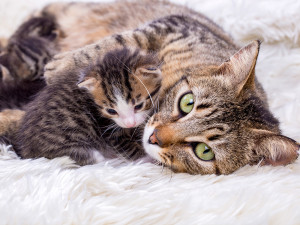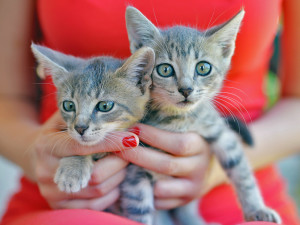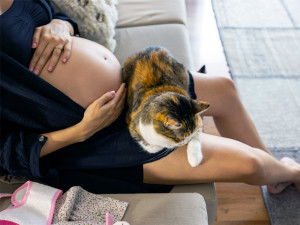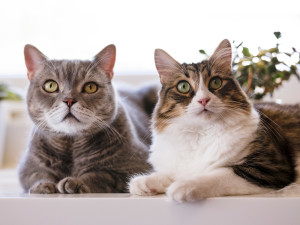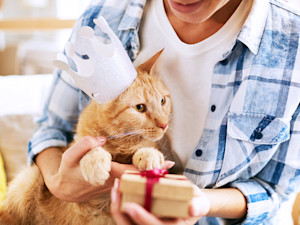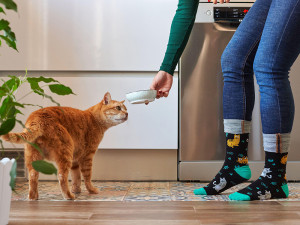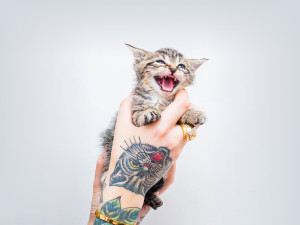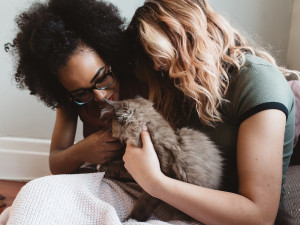How Young Can a Kitten Get Pregnant?
And at what age is it safe?

Share Article
In This Article:
Can A Kitten Get Pregnant?opens in a new tab Will Kittens Mate With Their Siblings?opens in a new tab What Age Is Safe For Breeding a Catopens in a new tab How Old Can Cats Become Pregnant?opens in a new tab
One of the decisions many new kitten parents have to make is when to have their kitten spayedopens in a new tab. The recommended age for getting a kitten spayed used to be six months or older, but now the recommendation is to do this at a much younger age. Early spaying nixes unwanted cat pregnancy and stops babies from having babies. Read on to find out how early a kitten can get pregnant.

Get (totally free) deals for food, treats, accessories, tech, and way more pet parenting must-haves.
opens in a new tabCan a kitten get pregnant?
Having a new kitten is a lot of fun and comes with a load of responsibilities. Even the most on-the-ball kitten parent can sometimes be surprised by how soon the topic of spaying comes up. I often hear questions like:
My kitten is on top of all of her wellness appointments, but my vet just asked me about scheduling a spay? Do I really need to start thinking about spay surgery already? She’s only four months old? Can a four month old kitten get pregnant?
How early a kitten can get pregnant depends on their breed, size, and overall health. Most kittens reach sexual maturity at around five months old, but some kittens undergo puberty as early as four months, meaning that it’s possible for a four-month-old kitten to get pregnant.
When should kittens get spayed?
The current recommendation is for kitten parents to pursue an early spay, meaning before their kitten reaches sexual maturity. The goal is to sterilize kittens before puberty, which happens around five months of age for most kittens.
Early kitten spays are typically performed around four months of age, but it can be performed as early as two months old, as long as the kitten is large enough (two pounds or more) and healthy enough to be anesthetized.
The “traditional” age to get a kitten spayedopens in a new tab is six months; however, a veterinary task force determined that waiting until this age delayed kitten adoptions and still led to countless unwanted pregnancies. The task force also found no health benefits associated with waiting. The recommendation to “fix by five” has been adopted by many veterinary organizations, including the American Animal Hospital Association (AAHA) and American Veterinary Medical Association (AVMA).
When do cats go into heat?
Cats are seasonally polyestrous, meaning they will have multiple estrus (heat) cycles during a specific time of year. Cats are considered “long-day breeders” because females tend to go into heat during the spring and summer when the days are long. In the United States, this means March to September; in Australia it would be September to March. This seasonality blesses (or curses) us with an explosion of kittensopens in a new tab every year.
If you’ve never lived with a cat in heat, count your lucky stars. It’s not something the majority of cat parents enjoy — it’s annoying and loud. Your cat being suddenly super cuddly may not sound so bad, but cats in heat can be stage-five clingersopens in a new tab. Signs that a cat is in heat include:
Vocalizing
Increased affection
Flagging her tail in the air
Restlessness
Attempting to escape and find a mate
Rubbing against objects and people
Decreased appetite
Frequent urination
Will kittens mate with their siblings?
Will kittens mate with their brothers and sisters? Yes. Can a kitten get pregnant by a sibling? Also, yes. Despite all the time that littermates spend together early in life, their bond doesn’t prevent them from mating once they reach sexual maturity.
Littermates can and will breed and create inbred kitten litters. Inbreeding reduces genetic diversity and leads to inbreeding depression, a term that describes how a population can become less fit for survival. Inbred kittens are more susceptible to congenital and acquired diseases. If you’re raising a litter of kittens, don’t wait until they’ve obviously gone into puberty to think about preventing mating between siblings. Planning on early spaying and neutering is a good strategy to prevent unplanned inbred kitten litters.
What age is safe for breeding a cat?
Cats should be sexually mature, fully grown, and healthy before breeding. When a cat checks all these boxes will vary by breed, but usually it’s somewhere between twelve and eighteen months of age. A kitten that has not reached her full size may have more difficulty giving birth. Every effort should be made to avoid unplanned pregnancies in cats. Anyone planning to intentionally breed their cat should do so thoughtfully and with veterinary guidance.
Potential cat breeders should ensure that they have adequate time, resources, and knowledge before attempting to breed their cat. Breeding cats should have extensive health screening to ensure they’re fit to be bred. This includes making sure they’re free of feline leukemia (FeLV), feline immunodeficiency virus opens in a new tab(FIV), intestinal parasites, and genetic disorders.
Cats should be fed a high-quality diet and be provided comfortable shelter that accommodates all aspects of pregnancy, whelping, and kitten-rearing. Pet parents need to keep a keen eye on the mother and her kittens, and be prepared to bottle-raise the litteropens in a new tab, should health issues arise. This can mean feeding and stimulating kittens every two to four hours around the clock.
Most importantly, potential cat breeders should really consider why they want to breed their cat. Money shouldn’t be the sole reason.
How old can cats become pregnant?
Cats can get pregnantopens in a new tab until they’re around 10 years old. But your senior catopens in a new tab should be basking in glorious sunlight and getting attention on demand, not raising her newborn kittens. Even when following common breeding guidelines, it’s recommended that female cats are retired from breeding once they’re six or seven years old.
Pregnancy in older cats is not without risk. Older cats carry a higher risk of having pregnancy complications, like still birth and dystocia (difficulty giving birth). Dystocia in cats is uncommon and can sometimes be treated with medications, but performing a cesarean section is often the best option to save the lives of both mom and kittens.
Senior female cats who are intact also have a higher risk of developing a uterine infection (pyometra). Pyometra is considered a surgical emergency. Spaying to remove the infected uterus gives a cat with pyometra the best chance to make a full recovery. Signs of pyometra in cats include:
Vaginal discharge
Distended abdomen
Abdominal pain
Fever
Vomiting
Lethargy
Bottom line
Kittens can become pregnant as early as four months of age. For this reason, it’s recommended that kitten parents pursue “early” spay surgery, which is performed before a kitten reaches sexual maturity. Having kittens spayed prevents unwanted littersopens in a new tab and can protect cats from reproductive issues like dystocia (difficulty giving birth) and pyometra (uterine infection). There aren’t many reasons to intentionally breed a cat, and this should only be done after intense research and with veterinary guidance.
References
Holst, Bodil Ström. “Feline Breeding and Pregnancy Management: What Is Normal and When to Intervene.” Journal of Feline Medicine and Surgery, vol. 24, no. 3, 25 Feb. 2022, pp. 221–231, https://doi.org/10.1177/1098612x221079708opens in a new tab.
Johnson, Aime K. “Normal Feline Reproduction: The Queen.” Journal of Feline Medicine and Surgery, vol. 24, no. 3, 25 Feb. 2022, pp. 204–211, https://doi.org/10.1177/1098612x221079706opens in a new tab.
Pistorius, Arthur and Ineke Blokker. “Statistical Analysis in Support of Maintaining a Healthy Traditional Siamese Cat Population.” Genetics Selection Evolution, vol. 53, no. 1, 6 Jan. 2021, https://doi.org/10.1186/s12711-020-00596-wopens in a new tab. Accessed 27 Jan. 2025.
“Responsible Cat Breeding Guidelines,” Welfare in Pet Trade. https://food.ec.europa.eu/system/files/2020-11/aw_platform_plat-conc_guide_cat-breeding.pdfopens in a new tab. Accessed 27 Jan. 2025.

Dr. Alycia Washington, DVM, MS
Alycia Washington, DVM, is a small animal emergency veterinarian based in North Carolina. She works as a relief veterinarianopens in a new tab and provides services to numerous emergency and specialty hospitals. Dr. Washington is also a children’s book author and freelance writer with a focus on veterinary medicine. She has a special fondness for turtles, honey bees, and penguins — none of which she treats. In her free time, Dr. Washington enjoys travel, good food, and good enough coffee.
Related articles
- opens in a new tab
Can Cats Sense Pregnancy?
Yes, cats can detect pregnancy in humans.
![Male and female cat lying side by side.]() opens in a new tab
opens in a new tabHow to Spot the Difference Between Male and Female Cats
There’s more to it than what you learned in health class.
![Woman giving Birthday present to ginger cat wearing crown.]() opens in a new tab
opens in a new tabCat-Age Chart: Calculating Your Cat’s Age in Human Years
Know what to look for at every stage.
![orange cat being given a small cat food bowl]() opens in a new tab
opens in a new tabHow Long Can Your Always-Hungry Cat Wait For Dinner?
Sometimes, they actually do need to eat.
![A hand holding a kitten with a cat tattooed at the hand.]() opens in a new tab
opens in a new tabHeads Up: It’s Officially “Kitten Season”
Hannah Shaw, aka Kitten Lady, on how you can care for orphaned kittens this spring.
![Two women, one with dark curly hair and deep skin and one with pink-blonde hair and lighter skin petting their grey cat]() opens in a new tab
opens in a new tabYes, You Should Spay/Neuter Your Cat. Here’s Why
A veterinarian breaks down how it keeps your pet healthy and curbs kitten overpopulation.
